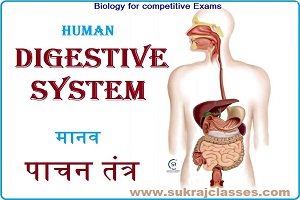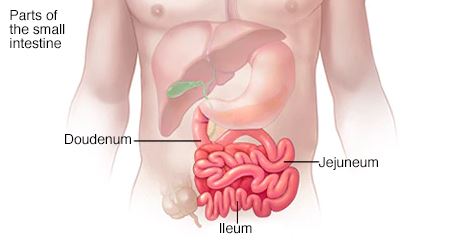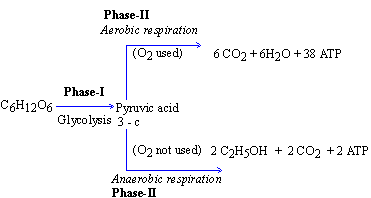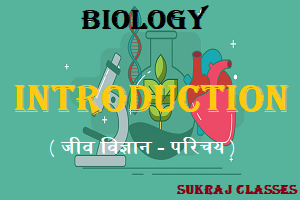
Human Digestive System (मानव पाचन तंत्र)- Biology
Biology topic – “Human Digestive System (मानव पाचन तंत्र)”, is important for all competitive exams like SSC CGL, SSC CHSL, RRB NTPC, UPSC and other state civil services exams. In these exams, almost 4-5 questions are coming from Biology. Let’s start topic – Human Digestive System (मानव पाचन तंत्र):-
Human Digestive System
(मानव पाचन तंत्र)
Digestive System of Human body includes many organs of our body like Mouth (Teeth, Tongue, and Thought), Oesophagus/ Esophagus (ग्रासनली/ ग्रसनी), Stomach (आमाशय/ जठर), Liver (यकृत), Pancreas (अग्न्याशय), Small intestines (छोटी आंत), Large intestine (बड़ी आँत) and Rectum (मलाशय). We have discussed many of these before. Today we will discuss role of these organs in human digestion process.
Human body needs food to provide it with Energy. However, in order to use food, we must first break it down into substances that the various organs and cells in our body can use. This is the job of our digestive system.
The digestive system acts in various stages to digest our food. Each stage is important and prepares the food for the next stage.
Major Stages and process of the Digestive System are:
1. Mouth (मुंह):
In mouth there are two process takes place:-
-
- Chewing (चबाना): Chewing is the first stage of the digestive system. When we chew our food it breaks up big pieces into little pieces that are easier to digest and swallow. Our mouth generate a water substance when we start eating food. This water substance is called saliva (or spit).
- One of the enzymes in saliva called amylase helps to break down the chewed food to make it all soft and easier to swallow.
- Our tongue pushes the food towards the teeth and then pushes the food in smaller bits towards the back of our throat.
- Swallowing (निगलना/गटकना) – Swallowing may seem like a simple process to us.
- Chewing (चबाना): Chewing is the first stage of the digestive system. When we chew our food it breaks up big pieces into little pieces that are easier to digest and swallow. Our mouth generate a water substance when we start eating food. This water substance is called saliva (or spit).
-
-
- The chewed food slides down the pharynx (गलकोष) or throat where the pharynx divides into two tubes. One, the esophagus (ग्रासनली/ ग्रसनी) leads to the stomach and the other, the windpipe or trachea (श्वासनली) leads to the lungs.
- When we swallow some food a flap called the epiglottis closes over the windpipe so that the food goes down where it should into the esophagus. Fortunately for us, it works automatically.
- If we are laughing or talking at the same time as eating then we sometimes may have food going down the wrong way. This means that the epiglottis didn’t move fast enough to close off the windpipe. Usually a good cough shoots the food back up into your mouth so we can swallow it down the right way next time.
-

2. Esophagus (ग्रासनली/ ग्रसनी)/ Alimentary canal (आहार नली) :-
- Once the food is in the esophagus it is moved along by peristalsis (क्रमाकुंचन- पेशियों की एक स्वयंभू लहरीली गति). This means that the walls of this tube squeeze the food along until it reaches the gateway to the stomach.
- This ‘gateway’ is called the esophageal sphincter muscle. It opens to let food pass into the stomach then quickly closes before any food or stomach acids can come back up.
- Length of our Alimentary canal is approx. 27 to 30 feet.
3. Stomach (आमाशय/ जठर) –
The next stage is the stomach which has an opening at the top end to the esophagus, and another at the lower end to the intestines. Food hangs out in the stomach for around four hours. While the food sits there, more enzymes go to work on it, breaking down things like proteins that our bodies can use. The stomach kills a lot of bad bacteria as well, so we don’t get sick.
4. Small intestines (छोटी आंत) –
- The small intestine is the longest part of the digestive system. It extends from the stomach to the large intestine and consists of three parts: Duodenum, Jejunum and ileum. The duodenum, the shortest, is where preparation for absorption through small finger-like protrusions (उभार) called villi (विल्ली) begins. Villi increase the internal surface area of the intestinal walls making available a greater surface area for absorption.
 Function : The main functions of the small intestine are to complete digestion of food and to absorb nutrients. The small intestine works with juices from the liver, pancreas and gallbladder to continue to break down our food where the food gets absorbed from the intestine and into our body through the blood. All the sugars, fats, proteins, vitamins and minerals can pass through the wall of the intestine into the blood.
Function : The main functions of the small intestine are to complete digestion of food and to absorb nutrients. The small intestine works with juices from the liver, pancreas and gallbladder to continue to break down our food where the food gets absorbed from the intestine and into our body through the blood. All the sugars, fats, proteins, vitamins and minerals can pass through the wall of the intestine into the blood.
Digested food ⇒ Blood ⇒ Cells ⇒ Mitochondria (power house of cell) where Aerobic respiration process takes place
- In Aerobic (where oxygen use) Respiration Process: –

Glucose (C6H12O6) is oxidized to produce carbon dioxide (6CO2) and oxygen (2O2) is reduced to produce water (6H2O).
- In Anaerobic (no oxygen use) Respiration Process: – Anaerobic respiration is the type of respiration through which cells can breakdown sugars to generate energy in the absence of oxygen.
The Liver (यकृत) and Pancreas (अग्न्याशय):
-
- The liver and pancreas both work with the small intestine. The liver provides bile (stored in the gall bladder) that helps break up fat into smaller bits. The pancreas provides additional enzymes to help digest all sorts of food. First stop for this blood is the liver.
-
-
- The liver sorts out the good stuff from the waste.
- It turns some of the waste into bile.
- It stores some of the sugars, fats, proteins and vitamins.
- It sends off the rest of the good stuff round the body to where it is needed.
- If our ‘small’ intestine was all straightened out it would measure nearly 6 metres (approx. 19-20 feet). It is thinner than the large intestine (which is shorter in length).
-
5. Large intestine (बड़ी आँत) –

- The Next stage is the large intestine. The ‘processed food’ now moves into the large intestine (which is called the colon) where more water is taken out until the waste becomes a lot thicker. By the time it reaches that bottom part of the large intestine it is very thick indeed.
- Any food that the body doesn’t need or can’t use is sent to the large intestine and later leaves the body as waste.
6. Rectum (मलाशय):-
- This is the last stage of our digestion process and it only remains to get rid of all the waste that our body cannot use.
- At the bottom of the large intestine is the rectum. At the bottom of the rectum there is a ring of muscle called the anus which stops anything coming out of our body until we are ready for it.
- When there is enough waste collected our brain instruct that we ‘need to go’.
For More:
Important Facts of Digestive System for Competitive Exams
- The digestive system is a human biological system that breakdown food so it can be absorbed and used by the body.
- The gastrointestinal tract (digestive tract), gallbladder, liver and pancreas make up the human digestive system.
- The gastrointestinal tract is one long hollow system of organs that starts at the mouth and ends at the anus.
- The flow of food through the human digestive system starts with the mouth, to the esophagus (ग्रासनली), to the stomach, to the small intestines, to the large intestines and finally the rectum.
- The mouth chews up the food, and your tongue will help push food into your throat.
- The esophagus will help move food from your throat into your stomach.
- Length of our Alimentary canal is approx. 27 to 30 feet.
- The stomach will further breakdown food using digestive fluids before moving it into our small intestines.
- The small intestines will mix fluids from the pancreas, liver and gallbladder with the food and start absorbing nutrients and water for absorption into our bloodstream, before moving into your large intestines.
- The liver produces bile that aids in fat digestion, stores important nutrients and helps filter out toxins.
- The pancreas regulates blood sugar and releases enzymes that aid the digestion of carbohydrates, fats and proteins.
- The large intestines continue to absorb water and converts liquid waste into a solid before moving it to our rectum.
- Extra food reserve/Store in Adipose tissues in form of Fat below our belly-skin.
- The digestive system of an adult, from beginning to end, is up to 30 feet in length.
- The small intestines can reach up to 20 feet in length and have a diameter of about an inch.
- The large intestines can reach up to 5 feet in length and have a diameter of about three inches.
- Food will take between 6 to 8 hours to move completely through the human digestive system.
If you like and think that Biology topic on “Human Digestive System (मानव पाचन तंत्र)” is helpful for you, Please comment us. Your comments/suggestions would be greatly appreciated. Thank you to be here. Regards – Team SukRaj Classes.





